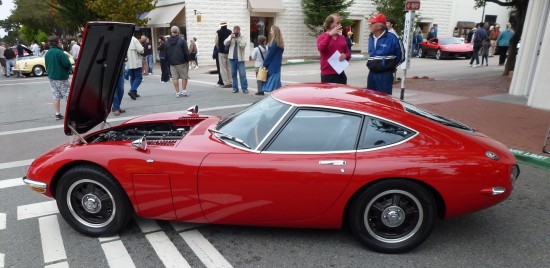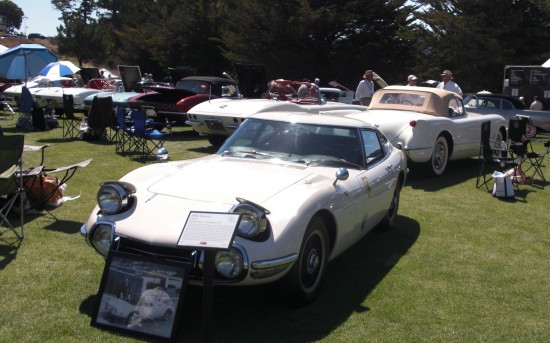by Mike –
The Toyota 2000GT was Toyota’s, and Japan’s, first grand touring car and first super car.
First shown at the Tokyo Motor Show in 1965, the 2000GT was produced for Toyota by Yamaha between 1967 and 1970. It was well received by the press, and the public and today is highly collectable.
Rare
Toyota 2000GTs are rare because only 354 were made between 1967 and 1970, this includes three made for Carroll Shelby to race in SCCA races.
The body is made of aluminum the headlights are pop-up and there are plexiglas covered driving lights on either side of the grille.
Toyota 2000GT Engine
The engine is a 2-liter straight-6 based on the engine for the Toyota Crown sedan. Yamaha reworked the engine into a double overhead camshaft 150 hp GT engine. A later model had a 2.3-liter engine. The transmission is a manual 5-speed and this Toyota could reach 135-140 MPH. All four wheels had power-assisted disc brakes.
Bond, James Bond
The 2000GT was in the James Bond movie, You Only Live Twice, as a convertible because Sean Connery could not fit into the coupe. The two cars used in the movie were not actually convertibles because they did not have a top but were made to look like they had a convertible top in the down position.
Toyota 2000GTs Are Valuable
Today the Toyota 2000GT is a rare car especially a left hand drive model because they only made 75. They are probably the first, and certainly the most desirable, Japanese collector car, which means they are expensive.
The latest issue of the Hagerty Price Guides lists a condition 1 2000GT at between $630,000 and $820,000 depending on the model.
The red 2000GT was photographed at the Carmel Concours On The Avenue in 2011 and the white 2000GT was photographed at the Hillsborough Concours d’Elegance in 2010. Both of these cars are left hand drive cars.
Yamaha made all of the 2000GTs. Why do you think that Toyota needed the help of Yamaha to make their first GT car?
Subscribe to My Car Quest














They subbed out the work to Yamaha for either of two reasons: a) They did not have the manufacturing capacity at the time, because the Japanese economy was booming, and they were cranking out bread & butter cars left and right b) Maybe they felt that with Yamaha’s extensive motorcycle experience, they would be better at producing a souped up sportscar. Or maybe some combination of both – whatever they did, it worked, because there would not be another critically acclaimed Japanese sportscar until the Datsun 240Z. Glenn in the Bronx, NY
Does anyone else have an idea?
It was a simple as “Cost & Schedule”. Toyota’s Manufacturing and Production facilities were set up for mass production, where huge amounts of working capital had to be applied to production tooling and design schedules stretched out over years.
The Toyota 2000GT was envisioned to be a limited production Flag Ship for Toyota. So Toyota turned to Yamaha for Yamaha’s ability to help engineer and build rapid design prototypes, as well as to produce limited production models at reasonable costs.
Toyota was aware that Yamaha’s Yasukawa Institute had been involved in the design of high performance sports cars for Japan since 1959. More recently Toyota knew that Yamaha had just finished working with Nissan in 1963/64 to produce rapid design prototypes of a joint development project also aimed at producing a modern sports car. Although the joint development project between Yamaha and Nissan had come to an abrupt end in 64. The Toyota Design Team was favorably impressed with the work Yamaha had recently completed.
Nissan at the time also subcontracted the manufacturing and production of their more limited production models. Although to a company in which Nissan had a 20% investment in as well. Nissan Shatai Kiko produced the Roadsters and the Z Cars.